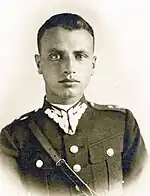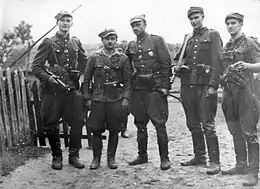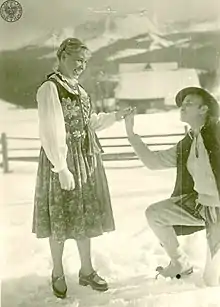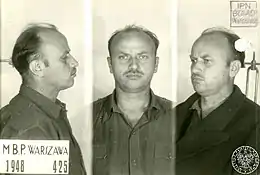Zygmunt Szendzielarz
Zygmunt Szendzielarz (12 March 1910 – 8 February 1951) was the commander of the Polish 5th Wilno Brigade of the Home Army (Armia Krajowa), nom de guerre "Łupaszka".[1] He fought against the Red Army after the end of the Second World War. Following the Soviet takeover of Poland at the end of World War II he was arrested, accused of numerous crimes and executed in the Mokotów Prison as one of the anti-communist cursed soldiers. After the fall of communism, in 1993, Szendzielarz was rehabilitated and declared innocent of all charges. In 2007 Polish president Lech Kaczyński posthumously awarded Szendzielarz with the order of Polonia Restituta. His involvement in the Dubingiai massacre of 1944, however, remains controversial.[2]
Zygmunt Szendzielarz | |
|---|---|
.jpg.webp) Rotmistrz Szendzielarz before 1948 | |
| Nickname(s) | Łupaszka, Łupaszko |
| Born | 12 March 1910 Stryj, Galicia, Austria-Hungary |
| Died | 8 February 1951 (aged 40) Mokotów Prison, Warsaw, Polish People's Republic |
| Cause of death | Execution by shooting |
| Awards | |
| Spouse(s) | 1. died 1945 2. Lidia Lwow-Eberle (unmarried) |
Life
Szendzielarz was born in Stryj (Austrian Partition, now Lviv Oblast, Ukraine), then part of the Austro-Hungarian Empire and from 1919 to 1939 in Poland, into the family of a railway worker. After graduating from primary school in Lwów, he attended a biological-mathematical gymnasium in Lwów and then Stryj. After graduating, he volunteered for the Polish Army and completed Infantry Non-commissioned officer School in Ostrów Mazowiecka (1932), then Cavalry NCO School in Grudziądz. He was promoted to lieutenant and transferred to Wilno, where he assumed command of a squadron in the 4th Uhlan Regiment.
World War II

With his unit, he took part in the 1939 September Campaign. His unit was attached to the Wilno Cavalry Brigade under General Władysław Anders, part of the Prusy Army. After retreating from northern Poland, the forces of Gen. Anders fought their way towards the city of Lwów and the Romanian Bridgehead. However, in the area of Lublin Szendzielarz's unit was surrounded and suffered heavy losses. Soon afterwards Szendzielarz was taken prisoner of war by the Soviets, but he managed to escape to Lwów, where he lived for a short period under a false name. He tried to cross the Hungarian border to escape from Poland and reach the Polish Army being formed in France, but failed and finally moved with his family to Wilno.
In Wilno, Szendzielarz started working on various posts under false names. In mid-1943 he joined the Home Army under the nom de guerre Łupaszka, after Jerzy Dąbrowski,[3] and in August he started organizing his own partisan group in the forests surrounding the city. Soon the unit was joined by local volunteers and the remnants of a unit of Antoni Burzyński ("Kmicic"), destroyed by Soviet Partisans and the Wehrmacht. By September, the unit was 700 men strong and was officially named the 5th Vilnian Home Army Brigade (5 Wileńska Brygada Armii Krajowej).

Łupaszko's unit fought against the German army and SS units in the area of southern Wilno Voivodeship, but was also frequently attacked by the Soviet Partisans paradropped in the area by the Red Army. In April 1944, Zygmunt Szendzielarz was arrested by the Lithuanian police and handed over to the Gestapo. Łupaszko was free in the same month under circumstances that remain unclear. In reprisal actions, his brigade captured several dozen German officials and sent several threatening letters to Gestapo but it remains unknown if and how these contributed to his release.
Dubingiai massacre
On 20 June 1944 a Lithuanian unit of the Schutzmannschaft murdered 39 Poles in Glinciszki, including women and children. Lithuanian collaborator units also harassed the Polish population in Pawłów, Adamowszczyzna, and Sieńkowszczyzna. In reprisal, on 23 June 1944, a unit of 5th Vilnian Home Army Brigade attacked the fortified village of Dubingiai, capturing a bunker defended by Lithuanian policemen. The order to attack the village was given by Szendzielarz.[4][5] Dubingiai became the target of the attack due to many of the policemen, and their families, responsible for the Glinciszki crime living there. Having the list of people who collaborated with the occupier, the Poles began action to avenge the death of the residents of Glinciszki.[5] According to historian Paweł Rokicki, the actions in Dubingiai were a war crime, and the deaths of the civilians were intentional.[2] In Dubingiai between 21 and 27 inhabitants of the village died, including women and children.[5]
Operation Ostra Brama
In August, the commander of all Home Army units in the Wilno area, Gen. Aleksander "Wilk" Krzyżanowski, ordered all six brigades under his command to prepare for Operation Tempest — a planned all-national rising against the German forces occupying Poland. In what became known as Operation Ostra Brama, Brigade V was to attack the Wilno suburb of Zwierzyniec in cooperation with advancing units of the 3rd Belorussian Front. However, Łupaszko, for fear of being arrested with his units by the NKVD and killed on the spot, disobeyed orders and moved his unit to central Poland. Wilno was liberated by Polish and Soviet forces, and the Polish commander was then arrested by the Soviets and the majority of his men were sent to Gulags and sites of detention in the Soviet Union.[6]
It is uncertain why Szendzielarz was not court-martialed for desertion. Most likely it was in fact General "Wilk" himself who ordered Łupaszko's unit away from the Wilno area, due to Łupaszko long having been involved in fighting with Soviet partisans and Wilk not wanting to provoke the Red Army. Łupaszko's unit remained in the forests and he decided to await the outcome of Russo-Polish talks held by the Polish Government in Exile. Meanwhile, the unit was reorganized and captured enough equipment to fully arm 600 men with machine guns and machine pistols.[7]
After World War II
After the governments of the United Kingdom and the United States broke the pacts with Poland and accepted the communist "Polish Committee of National Liberation" as the provisional government of Poland, Łupaszka restarted hostilities—this time against the new oppressor, in the ranks of Wolność i Niezawisłość organization. However, after several successful actions against the NKVD units in the area of Białowieża Forest, it became apparent that such actions would result in the total destruction of his unit.

In February 1945 his wife died and the nurse Lidia Lwow-Eberle became his partner.[8]
In September 1945, Zygmunt Szendzielarz moved with a large part of his unit to Gdańsk-Oliwa, where he remained underground while preparing his unit for a new partisan offensive against the Soviet-backed communist authorities of Poland. On 14 April 1946 Szendzielarz finally mobilized his unit and headed for the Tuchola Forest, where he started operations against the forces of the Internal Security Corps, Urząd Bezpieczeństwa and the communist authorities. Łupaszko was hoping that in the spring of 1946 the former Western Allies of Poland would start a new war against the Soviet Union and that the Polish underground units could prove useful in liberating Poland. However, when he realized that no such war was planned he decided to disband his unit. He saw the further fight as a waste of blood of his men and decided to retire from the open fight against the communists.

After several years underground, he was arrested by the UB on 28 June 1948, in Osielec near Nowy Targ. After more than two years of brutal interrogation and torture in Warsaw's Mokotów Prison he was sentenced to death on 2 November 1950 by the Soviet-controlled court-martial in Warsaw. He was executed on 8 February 1951, together with several other Home Army soldiers. Szendzielarz was 40 years old. His body was buried in an undisclosed location. During a 2013 exhumation Szendzielarz's remains were recovered and identified as one of roughly 250 bodies buried in a mass grave at the Meadow at Warsaw's Powązki Military Cemetery.[9]
Crimes against Humanity
The unit of Zygmunt Szendzielarz massacred civilians in 1944. The victims of the 5th AK Brigade were primarily women and children (about 75% of all those killed). They were shot as a result of the deliberate action of "Lupaszka". During the action in Dubinki, there was no fight, in particular with the Lithuanian police, which simply was not there. Findings from the Polish Institute of National Remembrance (IPN) leave no doubt that the retaliatory action of the 5th Home Army Brigade was a war crime on civilians.[10]
On 17 April 1945, the unit of Zygmunt Sendzielarz once again massacred civilians of Belarusian Origin in the Village of Narewka, Poland.[11]
Honours and awards
- Virtuti Militari, V class; for participation in the September 1939 campaign
- Cross of Valour (January 1944)
- Gold Cross, Virtuti Militari (25 June 1988) in recognition of outstanding deeds during the war
- Grand Cross of the Order of Polonia Restituta, awarded by Polish President Lech Kaczynski, 11 November 2007
References
- IPN (11 June 2003). "Przeglad Mediow: Wystawa IPN w Białymstoku". Białystok: Institute of National Remembrance. Archived from the original on 5 March 2012.
- Rokicki, Paweł (2015). "ZBRODNIA DUBIŃSKA A MAJOR "ŁUPASZKO"". pamiec.pl. Archived from the original on 10 February 2020. Retrieved 12 January 2022.
- "Łupaszka – the cursed soldier" Archived 2016-11-04 at the Wayback Machine, Pangea Magazine, June 8, 2014
- Wołkonowski, Jarosław (1996). Okręg Wileński Związku Walki Zbrojnej Armii Krajowej: w latach 1939-1945. p. 247.
- Wołkonowski i Łukomski |page=256
- Andrzej Kaczyński (2 October 2004). "Wielkie polowanie: Prześladowania akowców w Polsce Ludowej" [Great hunt: the persecutions of AK soldiers in the People's Republic of Poland]. Rzeczpospolita. No. 232. Archived from the original on 6 November 2011.
- Emilian Waluchowski (8 June 2014). "Łupaszka – the cursed soldier". Major Zygmunt Szendzielarz. Pangea Magazine. Archived from the original on 4 November 2016. Retrieved 2 November 2015.
- Remembrance, Institute of National. "We will bid our final farewell to Lidia Lwow-Eberle - a soldier of the Home Army, a legendary paramedic of the "Łupaszka" unit and the life companion of Maj. Zygmunt Szendzielarz - on 22 January at 1:00 p.m. at the Powązki Military Cemetery in Warsaw. Lidia Lwow-Eberle passed away on 5 January 2021". Institute of National Remembrance (in Polish). Retrieved 2021-12-05.
- Tomasz Leszkowicz (2013). "IPN ujawnia wyniki identyfikacji kolejnych ofiar UB. Wśród nich m.in. "Zapora" i "Łupaszka"". HistMag (in Polish) (2013–08–22).
- "Archived copy". pamiec.pl. Archived from the original on 10 February 2020. Retrieved 12 January 2022.
{{cite web}}: CS1 maint: archived copy as title (link) - "Fałszywy mit "Łupaszki"". 25 April 2016.
Further reading
- Kozłowski, Patryk (2004). Jeden z wyklętych. Zygmunt Szendzielarz "Łupaszko" (in Polish). Warszawa: Rytm. ISBN 83-7399-073-9.